Enochian Chess
Introduction
Chess variants are sometimes created and played in a particular subculture outside the chess community itself. Notable examples of such an origin include Tridimensional Chess, hailing from the world of Star Trek, and Gary Gygax's Dragonchess, an offspring of the Dungeons & Dragons role-playing phenomenon. Enochian chess, an interesting variation on Chaturanga for Four Players, also has its origins in a particular subculture, in this case the world of Victorian occultists.Enochian chess first appears to have been played by members of the Order of the Golden Dawn, who used their boards and pieces for divination as well as gameplay. Documentary evidence for the existence of the game (in the form of a Golden Dawn paper dating from no later than 1897) has come to light, but no historical documents discovered so far have given the complete rules for game play. Nobel Prize-winning poet and Golden Dawn member William Butler Yeats (1865-1939) records in his memoirs that in 1894 he played "a curious form of chess at which there should be four players" with two other members of the Golden Dawn. One of the other players was MacGregor Mathers (1854-1918), a founding father of the order. In his book The Golden Dawn noted occultist Israel Regardie (1907-1985) provides a description of the boards and the pieces used in Enochian chess. He also gives two arrays and the occult methodology whereby the others may be derived. Regardie attributes part of the information he provides, including the movement of the pieces, to an "Official Ritual" written by Mathers.
The Golden Dawn considered Enochian chess to be a secret teaching. At least partially because of this veil of secrecy, authorship of this variant is unclear. Golden Dawn founder Dr. Wynn Westcott (1848-1925) has been suggested as the inventor of this particular variant, but some (including Westcott himself) have claimed that the documents describing Enochian chess were among those supplied to him from an older occult group operating in Germany. The complete rules presented here are based upon a modern reconstruction by Golden Dawn student Chris Zalewski.
The magical practices of the Golden Dawn are of no concern to the chess variant community, so this essay will focus on Enochian chess as a game. Information of an occult nature will be omitted or glossed-over wherever possible.
Board
Enochian chess can be played on the 8x8 board of FIDE chess. (Golden Dawn members did not use orthodox boards. For more information on the traditional equipment used to play this variant, see Appendix I.) However, play is facilitated by making the corner spaces of the board at least twice as large as the other squares. After some experimentation the author of this essay found the following board to be particularly suitable:

Figure 1: Board
The four corner spaces (a1, a8, h1, h8) are the throne squares and have special properties involving the four kings that will be explained below.
Setup
Each of the four players begins with a king, a queen, a rook, a knight, a bishop and four special pawns. Enochian Chess allows for eight different initial arrangements of these pieces, each designated by reference to a combination of the classical 4 elements (fire, earth, water & air). One such array, "Air of Air & Water", is given below. For the others see Appendix II.

Figure 2: One Possible Setup
| YELLOW | king & bishop, a8 queen, b8 knight, c8 rook, d8 |
pawn of bishop, a7 pawn of queen, b7 pawn of knight, c7 pawn of rook, d7 |
| BLUE | king & bishop, h8 queen, h7 knight, h6 rook, h5 |
pawn of bishop, g8 pawn of queen, g7 pawn of knight, g6 pawn of rook, g5 |
| RED | king & bishop, h1 queen, g1 knight, f1 rook, e1 |
pawn of bishop, h2 pawn of queen, g2 pawn of knight, f2 pawn of rook, e2 |
| BLACK | king & bishop, a1 queen, a2 knight, a3 rook, a4 |
pawn of bishop, b1 pawn of queen, b2 pawn of knight, b3 pawn of rook, b4 |
In all eight initial arrangements each throne square is occupied by two pieces, a king and another piece (in the above case a bishop). This double occupancy is only allowed at the beginning of the game. Once either the king or the other piece moves off of the throne square then for the remainder of the game only one piece may sit on that particular throne square at any one time. Both pieces are captured if an enemy piece moves into a throne square while it is still occupied by the both original pieces.
Pieces
The king moves one step in any direction as in FIDE chess. More information concerning the king may be found in the Rules section.The queen moves by leaping two squares in any direction, as would an alibaba. The movement of a queen is illustrated in Figure 3. The queen has a special form of capture only allowed against other queens. For more information on this special case, see Rules.

Figure 3: Queen's Leap
The rook moves orthogonally as in FIDE chess. Castling is not allowed in Enochian chess.
The bishop moves diagonally as in FIDE chess, except that like the queen it has a special form of capture only allowed against other bishops. More information on this can be found in the Rules section.
The knight behaves exactly as it does in FIDE chess.
The four classes of pawn (pawn of queen, pawn of rook, pawn of bishop, and pawn of knight) behave much like FIDE pawns, moving one space forward or capturing one space in the forward diagonal. For yellow, "forward" constitutes movement towards row 1. For blue, forward movement is in the direction of column A. Red pawns move towards row 8 amd black pawns toward column H. Upon reaching the far rank/file, pawns can promote as in FIDE chess, except that promotion of pawns only occurs after a player has lost at least one pawn. Promotion must be delayed if all four of a player's pawn are uncaptured. Also, a pawn may only promote to its type. (A pawn of rook promotes to a rook, a pawn of knight promote to a knight, etc.) Furthermore, pawns are not allowed an initial double step.
Notes
Neither the original Golden Dawn material nor Zalewski's reconstruction use the "pawn of ..." terminology. Both simply refer to these pieces as pawns. The nomenclature has been adapted from Tamerlane chess in an attempt to clarify the promotion rules.Although Zalewski's reconstruction of the rules for Enochian chess may be sound, the author of this article cannot help but wonder if in an earlier version perhaps the queen and bishop moved more like their Chaturanga counterparts, i.e. the queen as a ferz (one square diagonally)and the bishop as an alfil (leaping 2 squares diagonally). Such a suggestion is merely speculation on the part of this essayist. Regardie and through him Mathers both support Zalewski's descriptions of the queen and bishop.
Rules
SummaryEnochian chess is a four player chess variant in which two teams (always blue & black versus red & yellow) strive to capture both kings of the opposing team.
Before Play Begins
Prior to the start of a game the players should choose which of the eight arrays they will use. The players will also need to determine what color each will play (thereby determining who will be on which team) and what color will go first. (The Golden Dawn had a special procedure for making these determinations that had no substantive impact on play. For a description of this procedure, see Appendix IV.) Once these issues are settled play may proceed, going clockwise around the board.
Team Play
There is no individual winner in Enochian chess. For example, if the blue army is eliminated from play and the black army goes on to the capture the red and yellow kings, then the team of blue and black have won the game.
Team members are normally forbidden from capturing each other's pieces, unless otherwise noted. Pieces belonging to armies on the same team do not threaten each other. (E.g. The blue and black kings can be adjacent without giving each other check.)
Capture of the King
Kings are not mated in Enochian chess, though players must warn their opponents that the king is threatend by declaring "check" as in FIDE chess. A king in check MUST be moved, even if that means putting the king in check again. The player with the king in check may move another piece only if the king is blocked by friendly pieces so that it cannot be moved out of check.
When a king is captured all the pieces of that color become frozen. They remain on the board, but are unable to move, do not threaten other pieces, nor can they be captured. They simply sit on the board acting as blocking terrain.
Seizing the Throne
Moving the king onto the throne square of a friendly player transfers control of the friendly army. The two armies still take separate turns, but are under the control of one player. Frozen pieces may be reactivated by this method. The player retains control of both armies even if the king that seized control is moved off of the throne square. If the usurping king is captured, control of the friendly army reverts to the original player, assuming that the army still has a king to lead it. Otherwise both armies are kingless and those players have lost the game.
Exchange of Prisoners
Two opposing players who have both captured enemy kings may agree to an exchange of prisoners. The exchange can only be made if both players with captured kings agree and neither have lost their own king. The kings are placed upon their own throne squares, or if a throne square is occupied, the nearest empty square. Zalewski does not indicate how to place a king if the thrones square is occupied and multiple alternative squares are equidistant from the throne square.
Frozen pieces revert to normal pieces when their king is brought back into play in this manner.
Priviledged Pawn
If a player is reduced to a king, a queen, and a pawn; a king, a bishop, and a pawn or a king and a pawn, then the pawn is considered to be priviledged. Upon reaching its normal promotion zone a priviledged pawn may be promoted to a queen, rook, bishop, or knight as the player chooses. In effect, the pawn becomes a normal FIDE pawn. However, if a priviledged pawn is promoted to a piece still in play, the original piece is demoted to the pawn of its type. This effect is illustrated by Figures 4 and 5.

Figure 4: Before Using Pawn Privilege
Black has a pawn of bishop ready to promote and sees an opportunity to fork red's king and rook. Since the pawn of bishop is priviledged, black chooses promotes to a queen. Black already has a queen on the board, which is demoted to a pawn of queen.
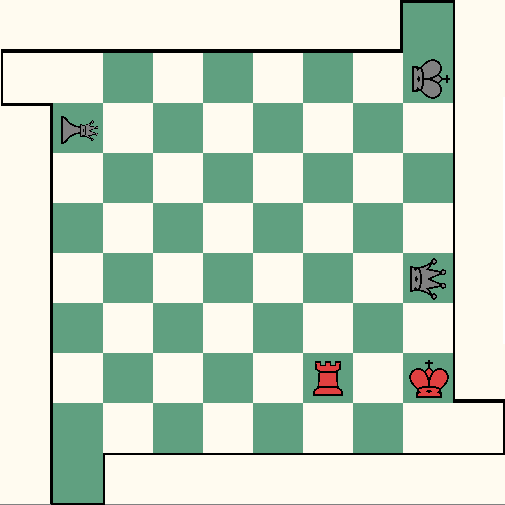
Figure 5: After Using Pawn Privilege
What would happen if the above scenario were to involve a pawn of queen instead of a pawn of rook? Zalewski is unclear on this point, but it could be guessed that the original queen can avoid demotion, allowing two black queens on the board. Otherwise the player would be penalized for having priviledge.
Concourse of Bishoping
A perusal of the eight possible arrays reveals that opposing bishops are bound on opposite colors. The special case known as the concourse of bishoping allows bishops to capture enemy bishops. The concourse of bishoping is similar to the triumph of the boat found in Chaturanga for Four Players. By completing a 2x2 square formation involving all four bishops, the moving bishop takes all three other bishops. A concourse is a special case in which capturing a teammate's piece is legal.

Figure 6: Concourse of Bishoping
In Figure 6 above if the black bishop were to move to e4 it would complete the concourse, capturing all three of the other bishops. Unlike the triumph of the boat, the concourse maneuver is legal in only five positions on the board. A concourse can happen either at c4, c5, d4, & d5 as illustrated above and at the sets (b2, b3, c2, c3) or (b6, b7, c6, c7) or (f6, f7, g6, g7) or (f2, f3, g2, g3). The other four concourse locations are illustrated by Figure 7.

Figure 7: The Other Four Concourses
Concourse of Queens
Opposing queens are also bound on opposite colors. A concourse of queens occurs under exactly the same circumstances as a concourse of bishoping. Bishops and queens may not be combined in a single concourse capture. All pieces involved must be either bishops OR queens.
Bare King
When two players on the same team are both reduced to bare kings the game is a draw.
Withdrawing
A player may withdraw from the game at any time, leaving their pieces in command of their teammate. If the withdrawing player has only a bare king, the remaining teammate is allowed to move either the bare king or their own pieces on BOTH colors' turns. If any other pieces remain in the army of the withdrawing player, then each color army may only be moved on its own turn.
Stalemate
If a player has no move available except such that would put their unchecked king into check, that player is stalemated. Play continues, but the player is not allowed to take a turn until such time as a move by another player alleviates the stalemate condition. The game is drawn if a player is stalemated and their teammate is also currently out of the game (teammate also stalemated, teammate's king captured, teammate withdrawn or the stalemated king has seized a friendly throne).
Two or Three Player Games Enochian chess may be played with fewer than four players by having one or both players command two armies. Each color still receives its own turn and pieces cannot be played out of turn. (E.g. If one player is playing both red and yellow, no red pieces may be moved during the yellow turn unless the yellow army has taken control of the red army.) A player operating both armies may not withdraw as described above.
Bibliography
Howe, Ellic. The Magicians of the Golden Dawn. London: Routledge & Kegan Paul, 1972.Regardie, Israel. The Golden Dawn. St. Paul: Llewellyn Publications, 1989.
Yeats, W(illiam) B(utler). Memoirs trans. and edited by Denis Donoghue. New York: Macmillan Publishing, 1973.
Zalewski, Chris. Enochian Chess of the Golden Dawn. St. Paul: Llewellyn Publications, 1994.
(Please note that off the four texts listed above, only Regardie and Zalewski will be of any possible use to the chess variantist. The others are cited only to help establish the historical pedigree for Enochian chess.)
Appendix I: Traditional Enochian Chess Equipment
 Figure 8: The Air Board |
Enochian chess was traditionally played on one of four specially constructed boards. Each board represented on of the classical elements. Each square of each board was divided into 4 triangles, which were painted one of four different colors. These triangles were not game spaces themselves, merely components of the larger square cells used to play the game. Although confusing to the eye, an Enochian chessboard is functionally identical to a FIDE 8x8 board. |
| The pieces used in Enochian chess were generally stiff paper stand-ups much like the paper dolls and paper toy soldiers of the era. Each major piece had a unique name and design taken from Egyptian mythology and all the pieces were painted in four-color paint schemes. Figure 9 depicts the front of an example piece. Each piece was mounted upright on a base colored red, yellow, blue, or black to show its affiliation. The back of the pieces were each painted a solid color depending on piece type: Kings were painted white on the reverse. Knights were red. Queens were painted blue. Bishops were yellow and rooks were black. |  Figure 9: Horus, the black knight |
Appendix II: Alternate Arrays
The setup described in the main body of this essay is one of eight provided by Zalewski. The seven other possible set-ups are given below. All eight are equally valid arrays, with no preference given between them. Regardie indicates that there are 16 possible arrays, but Zalewski concludes that there are only eight arrays because there are eight pairs of arrays that are functionally identical. For example, the arrays "Air of Fire" and "Air of Earth" have the exact same piece arrangement. Therefore these two arrays are listed below under a single category, "Air of Fire & Earth".

Figure 10: Air of Fire & Earth
| YELLOW | king & bishop, a8 rook, b8 knight, c8 queen, d8 |
pawn of bishop, a7 pawn of rook, b7 pawn of knight, c7 pawn of queen, d7 |
| BLUE | king & bishop, h8 rook, h7 knight, h6 queen, h5 |
pawn of bishop, g8 pawn of rook, g7 pawn of knight, g6 pawn of queen, g5 |
| RED | king & bishop, h1 rook, g1 knight, f1 queen, e1 |
pawn of bishop, h2 pawn of rook, g2 pawn of knight, f2 pawn of queen, e2 |
| BLACK | king & bishop, a1 rook, a2 knight, a3 queen, a4 |
pawn of bishop, b1 pawn of rook, b2 pawn of knight, b3 pawn of queen, b4 |
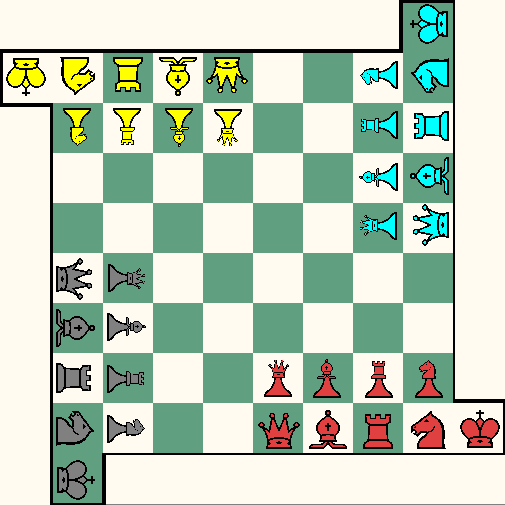
Figure 11: Fire of Air & Water
| YELLOW | king & knight, a8 rook, b8 bishop, c8 queen, d8 |
pawn of knight, a7 pawn of rook, b7 pawn of bishop, c7 pawn of queen, d7 |
| BLUE | king & knight, h8 rook, h7 bishop, h6 queen, h5 |
pawn of knight, g8 pawn of rook, g7 pawn of bishop, g6 pawn of queen, g5 |
| RED | king & knight, h1 rook, g1 bishop, f1 queen, e1 |
pawn of knight, h2 pawn of rook, g2 pawn of bishop, f2 pawn of queen, e2 |
| BLACK | king & knight, a1 rook, a2 bishop, a3 queen, a4 |
pawn of knight, b1 pawn of rook, b2 pawn of bishop, b3 pawn of queen, b4 |

Figure 12: Water of Air & Water
| YELLOW | king & queen, a8 bishop, b8 rook, c8 knight, d8 |
pawn of queen, a7 pawn of bishop, b7 pawn of rook, c7 pawn of knight, d7 |
| BLUE | king & queen, h8 bishop, h7 rook, h6 knight, h5 |
pawn of queen, g8 pawn of bishop, g7 pawn of rook, g6 pawn of knight, g5 |
| RED | king & queen, h1 bishop, g1 rook, f1 knight, e1 |
pawn of queen, h2 pawn of bishop, g2 pawn of rook, f2 pawn of knight, e2 |
| BLACK | king & queen, a1 bishop, a2 rook, a3 knight, a4 |
pawn of queen, b1 pawn of bishop, b2 pawn of rook, b3 pawn of knight, b4 |

Figure 13: Earth of Fire & Earth
| YELLOW | king & rook, a8 bishop, b8 queen, c8 knight, d8 |
pawn of rook, a7 pawn of bishop, b7 pawn of queen, c7 pawn of knight, d7 |
| BLUE | king & rook, h8 bishop, h7 queen, h6 knight, h5 |
pawn of rook, g8 pawn of bishop, g7 pawn of queen, g6 pawn of knight, g5 |
| RED | king & rook, h1 bishop, g1 queen, f1 knight, e1 |
pawn of rook, h2 pawn of bishop, g2 pawn of queen, f2 pawn of knight, e2 |
| BLACK | king & rook, a1 bishop, a2 queen, a3 knight, a4 |
pawn of rook, b1 pawn of bishop, b2 pawn of queen, b3 pawn of knight, b4 |
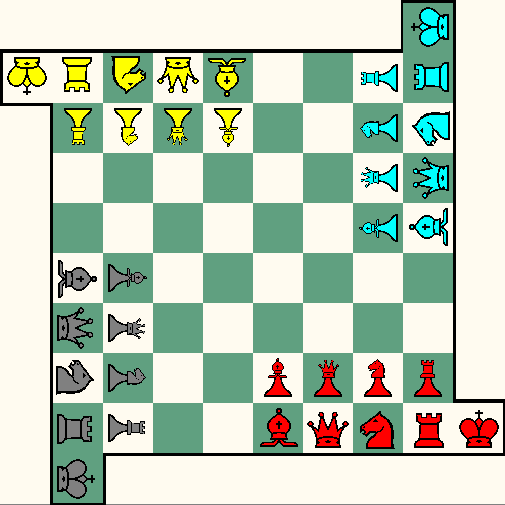
Figure 14: Earth of Air & Water
| YELLOW | king & rook, a8 knight, b8 queen, c8 bishop, d8 |
pawn of rook, a7 pawn of knight, b7 pawn of queen, c7 pawn of bishop, d7 |
| BLUE | king & rook, h8 knight, h7 queen, h6 bishop, h5 |
pawn of rook, g8 pawn of knight, g7 pawn of queen, g6 pawn of bishop, g5 |
| RED | king & rook, h1 knight, g1 queen, f1 bishop, e1 |
pawn of rook, h2 pawn of knight, g2 pawn of queen, f2 pawn of bishop, e2 |
| BLACK | king & rook, a1 knight, a2 queen, a3 bishop, a4 |
pawn of rook, b1 pawn of knight, b2 pawn of queen, b3 pawn of bishop, b4 |
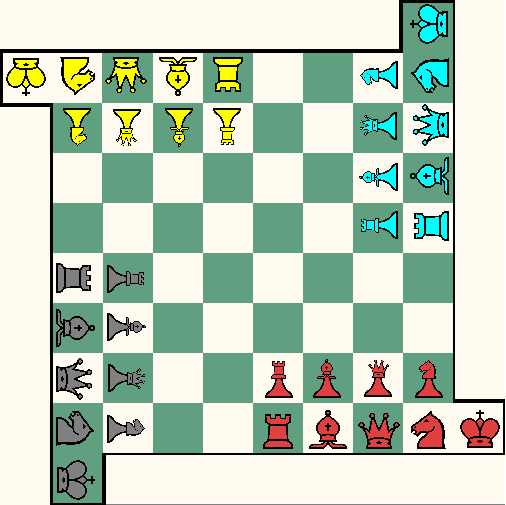
Figure 15: Fire of Fire & Earth
| YELLOW | king & knight, a8 queen, b8 bishop, c8 rook, d8 |
pawn of knight, a7 pawn of queen, b7 pawn of bishop, c7 pawn of rook, d7 |
| BLUE | king & knight, h8 queen, h7 bishop, h6 rook, h5 |
pawn of knight, g8 pawn of queen, g7 pawn of bishop, g6 pawn of rook, g5 |
| RED | king & knight, h1 queen, g1 bishop, f1 rook, e1 |
pawn of knight, h2 pawn of queen, g2 pawn of bishop, f2 pawn of rook, e2 |
| BLACK | king & knight, a1 queen, a2 bishop, a3 rook, a4 |
pawn of knight, b1 pawn of queen, b2 pawn of bishop, b3 pawn of rook, b4 |
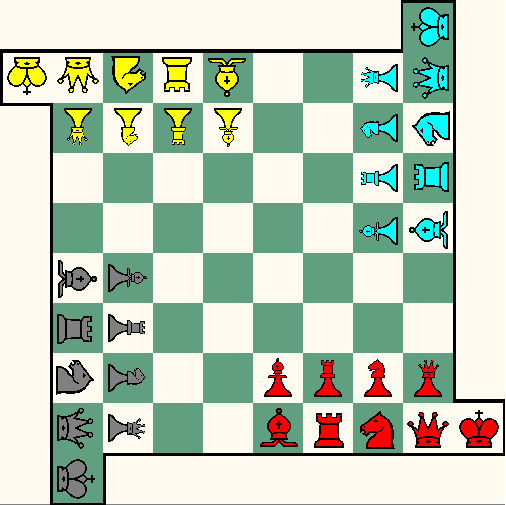
Figure 16: Water of Fire & Earth
| YELLOW | king & queen, a8 knight, b8 rook, c8 bishop, d8 |
pawn of queen, a7 pawn of knight, b7 pawn of rook, c7 pawn of bishop, d7 |
| BLUE | king & queen, h8 knight, h7 rook, h6 bishop, h5 |
pawn of queen, g8 pawn of knight, g7 pawn of rook, g6 pawn of bishop, g5 |
| RED | king & queen, h1 knight, g1 rook, f1 bishop, e1 |
pawn of queen, h2 pawn of knight, g2 pawn of rook, f2 pawn of bishop, e2 |
| BLACK | king & queen, a1 knight, a2 rook, a3 bishop, a4 |
pawn of queen, b1 pawn of knight, b2 pawn of rook, b3 pawn of bishop, b4 |
Appendix III: Why "Enochian" Chess?
Enochian chess is named after the Biblical patriarch Enoch, father of Methusaleh. In an occult tradition going back at least to the reign of Queen Elizabeth I, Enoch is considered a source hidden mystical knowledge, for he "walked with God" (Genesis 5:24) and "was taken from this life, so that he did not experience death" (Hebrews 11:5).
Initially this chess variant was also called Rosicrucian chess, after the Order of the Rosy Cross, a continental mystic fraternity from which the Order of the Golden Dawn claimed descent.
Appendix IV: Traditional Starting Procedure
The first step to playing Enochian chess in the traditional manner is to select which of the four elemental boards will be used. This choice also determines which army moves first. On the air board yellow moves first. On the fire board red moves first. On the water board blue moves first. On the earth board black moves first.The players then agree upon an array to be used. If playing on the fire or earth boards then only "... of fire & earth" arrays may be selected. If playing on the air or water boards then only "... of air & water" boards may be used.
Then players throw dice. In order from highest total to lowest each player in turn selects which army they will play, thereby determining their teams in the process.
(This dice method seems odd. The players with the second and third highest total on the dice determine the composition of the teams. The player who won the die roll gets the priviledge of choosing which army to operate (and whether or not that player gets the first move), but the "winner" is then at the mercy of others in regards to choosing a teammate.)
